Computex 2007: AMD's Barcelona and Other Products
by Gary Key on June 11, 2007 4:00 AM EST- Posted in
- Trade Shows
abit
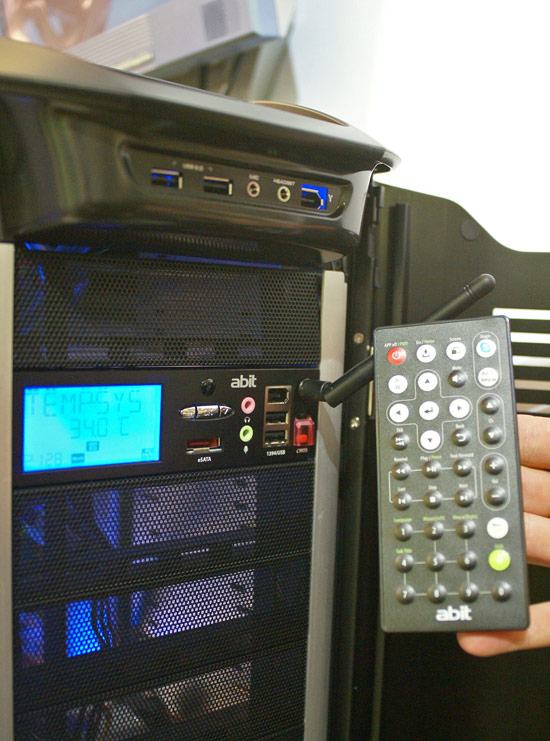
abit was displaying the new version 3.0 of their µGuru panel that features WiFi support. This enables you to control tuning aspects and software applications with the new remote control unit from anywhere in the room. So, if you're sitting in a recliner on the other end of the room and suddenly feel the need to modify your system overclock, you no longer need to get up and cross the room.

While abit showed off an impressive lineup of P35 motherboards that we will review shortly, we found a little gem hiding in the back room of the display booth. The new AN-M2HD is based on the just released NVIDIA 7050/630i chipset combination and should be an excellent overclocker for current AM2 processors as verified in early testing. We will have more on this motherboard and the X38 lineup shortly.
ASUS
ASUS offers a complete line of products for the PC and always has some interesting technology to view at the various tradeshows.
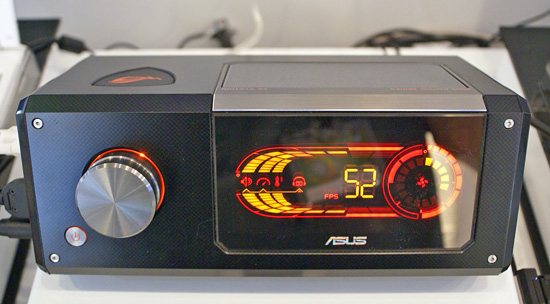
The ASUS XG Station was first shown at CES this year and is a complete external drop in solution for your notebook. The system was demonstrated with an NVIDIA 8600GT and should be ready for market shortly. The delay was caused by additional programming requirements for Vista compatibility along with certification for the latest video card choices.
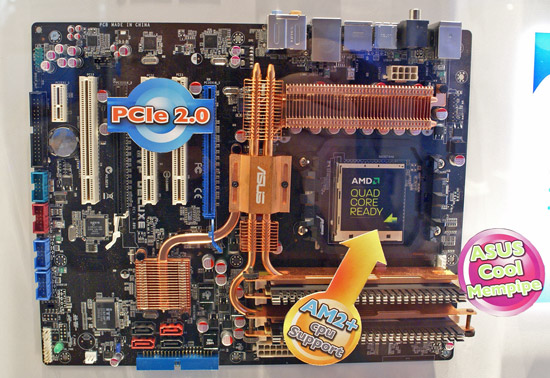
The ASUS M3A32-MVP Deluxe is based on the upcoming AMD RD790 chipset that features full support for AM2/AM2+ processors, HyperTransport 3, CrossFire, and DDR2-1066. The chipset is coming along well although we expect a couple of additional silicon spins before an estimated release date in late September of this year. Hopefully, AMD will be on schedule this time with a chipset introduction, though as mentioned earlier the new Agena based processors may not be available until December. One of the new features that ASUS was touting is the memory heatpipe system that is attached to the Northbridge heatpipe unit. Whether this will make it into in production is unknown at this time, but early thermal results are promising. Unfortunately, the current system only works with two DIMM slots occupied.
MSI
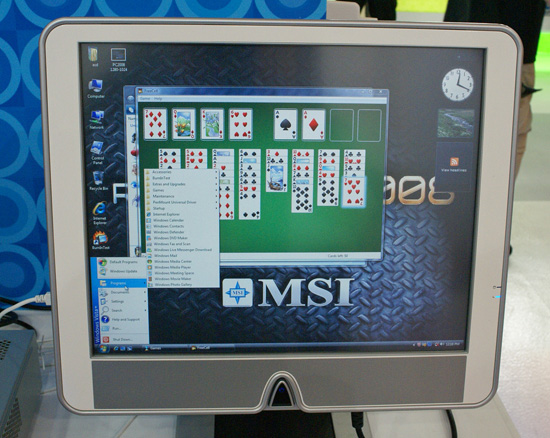
MSI had several new products in their booth this year but the Crystal 945 Touch panel PC caught our eye for those who like an all-in-one PC combination. The unit features the 945G/ICH7 chipset combination, 2GB of DDR2-667 memory, Pentium 4/D support, an 8-in-1 flash card reader, support for 2.5" IDE HDD and Slim design ODD units with a 17" touch screen panel. We found the system was very responsive and intuitive to use for a Windows based PC and it offers a fairly small footprint.
Shuttle
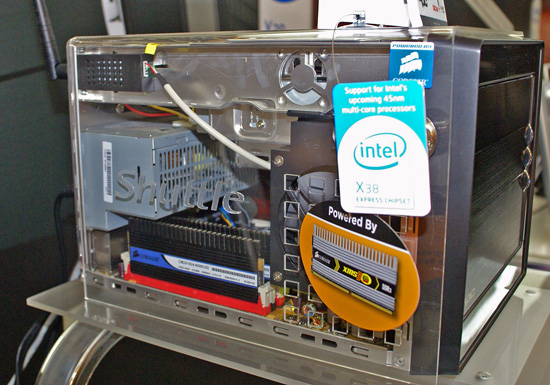
Shuttle was very excited to show off their new SFF unit, the SX38P3 Deluxe. The SX38 is based on Intel's new X38 chipset. Shuttle has managed to fit this chipset along with CrossFire capabilities into a revised SFF case that features their OASIS cooling technology. The system also features dynamic overclocking, 802.11 b/g WiFi, Bluetooth, Fingerprint recognition, and an 80%+ efficient certified power supply.

abit was displaying the new version 3.0 of their µGuru panel that features WiFi support. This enables you to control tuning aspects and software applications with the new remote control unit from anywhere in the room. So, if you're sitting in a recliner on the other end of the room and suddenly feel the need to modify your system overclock, you no longer need to get up and cross the room.

While abit showed off an impressive lineup of P35 motherboards that we will review shortly, we found a little gem hiding in the back room of the display booth. The new AN-M2HD is based on the just released NVIDIA 7050/630i chipset combination and should be an excellent overclocker for current AM2 processors as verified in early testing. We will have more on this motherboard and the X38 lineup shortly.
ASUS
ASUS offers a complete line of products for the PC and always has some interesting technology to view at the various tradeshows.

The ASUS XG Station was first shown at CES this year and is a complete external drop in solution for your notebook. The system was demonstrated with an NVIDIA 8600GT and should be ready for market shortly. The delay was caused by additional programming requirements for Vista compatibility along with certification for the latest video card choices.

The ASUS M3A32-MVP Deluxe is based on the upcoming AMD RD790 chipset that features full support for AM2/AM2+ processors, HyperTransport 3, CrossFire, and DDR2-1066. The chipset is coming along well although we expect a couple of additional silicon spins before an estimated release date in late September of this year. Hopefully, AMD will be on schedule this time with a chipset introduction, though as mentioned earlier the new Agena based processors may not be available until December. One of the new features that ASUS was touting is the memory heatpipe system that is attached to the Northbridge heatpipe unit. Whether this will make it into in production is unknown at this time, but early thermal results are promising. Unfortunately, the current system only works with two DIMM slots occupied.
MSI

MSI had several new products in their booth this year but the Crystal 945 Touch panel PC caught our eye for those who like an all-in-one PC combination. The unit features the 945G/ICH7 chipset combination, 2GB of DDR2-667 memory, Pentium 4/D support, an 8-in-1 flash card reader, support for 2.5" IDE HDD and Slim design ODD units with a 17" touch screen panel. We found the system was very responsive and intuitive to use for a Windows based PC and it offers a fairly small footprint.
Shuttle

Shuttle was very excited to show off their new SFF unit, the SX38P3 Deluxe. The SX38 is based on Intel's new X38 chipset. Shuttle has managed to fit this chipset along with CrossFire capabilities into a revised SFF case that features their OASIS cooling technology. The system also features dynamic overclocking, 802.11 b/g WiFi, Bluetooth, Fingerprint recognition, and an 80%+ efficient certified power supply.










64 Comments
View All Comments
MrEMan - Monday, June 11, 2007 - link
So, can someone explain to me what exactly AMD has gotten from its (paid) collaboration with IBM?It seems that once again IBM is unable to deliver on converting from lab design to actual production implementation.
defter - Monday, June 11, 2007 - link
I recall that AMD has licensed some process technology from IBM (including SOI).
??? Barcelona is AMD's design, it has nothing to do with IBM.
MrEMan - Monday, June 11, 2007 - link
Yes, Barcelona is strictly AMD's design, but are the problems being encountered due to the design, or the manufacturing of the new processors?It seems to me that it is more a manufacturing problem, because the current Athlons and Opterons haven't had any great performance enhancements/clock speed increases over the last few years.
TA152H - Monday, June 11, 2007 - link
Neither have Intel products. The fastest product they released was 3.8 GHz, and that was two or three years ago?Neosis - Tuesday, June 12, 2007 - link
Are you comparing a netburst based CPU with these ones?Do you have any idea about Integer Pipelines and Cache Latency?
defter - Monday, June 11, 2007 - link
Sub 2GHz speeds and motherboard issues cannot have anything to do with manufacturing issues.Even though 65nm K8s have very low clockspeeds, they are capable of reaching 2.6GHz@65W TDP (2 cores), thus hypothetical K8 based quad core would reach at least 2.6GHz@130W TDP. Since Barcelonas clockspeed is currently limited to 1.6-1.8GHz there must be significant issues with the design itself.
archcommus - Monday, June 11, 2007 - link
Let's face it, AMD has no hopes until at least early-mid next year, and that's assuming things DO improve significantly. Maybe they can keep themselves afloat with mediocre video, notebook, and low-power chip sales until then. Who knows what they've been doing there for the past four years since the original A64 launch. I know they had a cancelled project, but that still doesn't explain this kind of delay/lack of progress over that much time.But in the end, you can't win them all. AMD was king a couple years back, and now they're losing. They won't go out of business, and maybe they'll be a completely different company with their first 45 nm/next gen products.
In the meantime, I guess I'm betting on a cheap C2Q upgrade sometime in the next year.
nicolasb - Monday, June 11, 2007 - link
There are number of references to "RD600" in this article that should probably read "R600".Gary Key - Monday, June 11, 2007 - link
Sorry about that, corrected, it was a long flight home yesterday. ;-)clairvoyant129 - Monday, June 11, 2007 - link
Not surprising, scaling is terrible... by the time AMD rolls out 2.6GHz, forget Penryn, Intel will have Nehalem out.